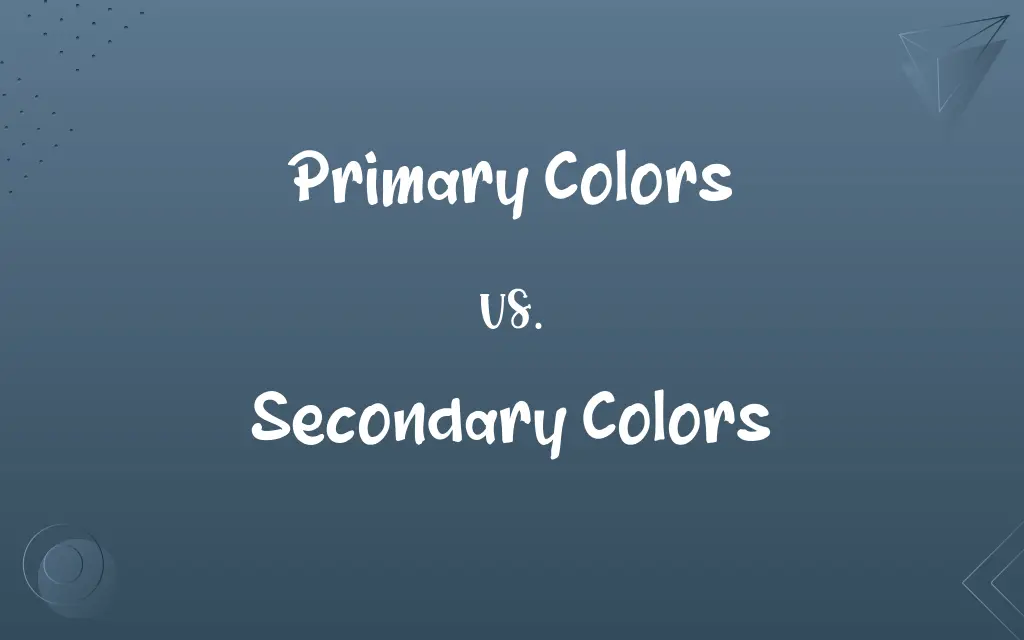Primary Colors vs. Secondary Colors: Know the Difference

By Shumaila Saeed || Published on January 18, 2024
Primary colors are the basic colors (red, blue, yellow) that cannot be created by mixing other colors, while secondary colors (green, orange, purple) are formed by mixing primary colors.

Key Differences
Primary Colors, consisting of red, blue, and yellow, are the foundational colors in color theory. They cannot be created by mixing other colors. These colors are key to creating a wide spectrum of other colors, including secondary colors. Secondary Colors, namely green, orange, and purple, are created by mixing two primary colors in equal parts.
Shumaila Saeed
Jan 18, 2024
In the RGB color model used in digital media, the primary colors are red, green, and blue. When these primary colors are mixed, they create secondary colors. For example, mixing blue and red makes magenta, a secondary color. In the traditional color wheel used in art and design, mixing the primary colors red and yellow results in orange, a vibrant secondary color.
Shumaila Saeed
Jan 18, 2024
Secondary Colors depend on the combination of primary colors. For example, combining red and blue yields purple. The intensity and shade of secondary colors can vary based on the proportions of primary colors mixed. In contrast, primary colors are pure and constant; they do not vary in hue or intensity.
Shumaila Saeed
Jan 18, 2024
Understanding primary and secondary colors is crucial in various fields like art, design, and even psychology. Primary colors are often used for their bold and direct appeal, while secondary colors offer more nuanced and complex visual effects. Both primary and secondary colors play significant roles in color theory, each serving different purposes in visual arts, design, and aesthetics.
Shumaila Saeed
Jan 18, 2024
Comparison Chart
Definition
Basic colors that cannot be mixed from others
Colors made by mixing two primary colors
Shumaila Saeed
Jan 18, 2024
ADVERTISEMENT
Use in Color Theory
Basis for creating other colors
Result of mixing primary colors
Shumaila Saeed
Jan 18, 2024
Primary Colors and Secondary Colors Definitions
Primary Colors
Primary Colors cannot be created by mixing other colors.
He was fascinated to learn that primary colors are pure and cannot be made by mixing.
Shumaila Saeed
Jan 10, 2024
ADVERTISEMENT
Secondary Colors
Secondary Colors are integral in creating a comprehensive color palette.
The artist's palette included both primary and secondary colors for diversity.
Shumaila Saeed
Jan 10, 2024
Primary Colors
Primary Colors are the basic set of colors that form the foundation for color theory.
In her art class, she learned that red, blue, and yellow are primary colors.
Shumaila Saeed
Jan 10, 2024
Secondary Colors
Secondary Colors are created by mixing two primary colors.
She mixed blue and yellow to get green, a secondary color.
Shumaila Saeed
Jan 10, 2024
Primary Colors
Primary Colors in additive color systems are red, green, and blue.
For digital screens, the primary colors are red, green, and blue.
Shumaila Saeed
Jan 10, 2024
Secondary Colors
Secondary Colors vary in shade depending on the mix ratio of the primary colors.
By adjusting the ratio of red to yellow, he created different shades of orange.
Shumaila Saeed
Jan 10, 2024
ADVERTISEMENT
Primary Colors
Primary Colors are used as the starting point for creating a wide range of other colors.
By mixing primary colors, she created an array of different hues.
Shumaila Saeed
Jan 10, 2024
Secondary Colors
Secondary Colors offer more complex hues compared to primary colors.
The secondary colors in the landscape brought a sense of complexity to the artwork.
Shumaila Saeed
Jan 10, 2024
Primary Colors
Primary Colors are essential in learning basic color mixing and color theory.
Understanding primary colors is key to mastering color theory.
Shumaila Saeed
Jan 10, 2024
Secondary Colors
Secondary Colors in traditional color theory are green, orange, and purple.
In his painting, the use of secondary colors like orange and purple added depth.
Shumaila Saeed
Jan 10, 2024
Repeatedly Asked Queries
What's an example of a Secondary Color?
Green, made by mixing blue and yellow.
Shumaila Saeed
Jan 18, 2024
What are Secondary Colors?
These are colors formed by mixing two primary colors.
Shumaila Saeed
Jan 18, 2024
Are Primary Colors the same in all color models?
No, they differ; for instance, in RGB, primary colors are red, green, and blue.
Shumaila Saeed
Jan 18, 2024
What happens when you mix a Primary Color with a Secondary Color?
Mixing a Primary Color with a Secondary Color can create a wide range of colors, depending on the proportions used.
Shumaila Saeed
Jan 18, 2024
Can Primary Colors be created by mixing other colors?
No, primary colors are pure and cannot be made by mixing.
Shumaila Saeed
Jan 18, 2024
Can Secondary Colors be mixed to create other colors?
Yes, Secondary Colors can be further mixed to create intermediate or tertiary colors.
Shumaila Saeed
Jan 18, 2024
Are Secondary Colors considered less important than Primary Colors in art?
No, Secondary Colors are essential in art as they are used to create a wide range of colors and are crucial for color mixing.
Shumaila Saeed
Jan 18, 2024
Are Secondary Colors commonly used in graphic design?
Yes, Secondary Colors play a significant role in graphic design as they allow designers to create visually appealing color palettes.
Shumaila Saeed
Jan 18, 2024
How do Secondary Colors differ from Tertiary Colors?
Secondary Colors are created by mixing two Primary Colors, while Tertiary Colors are created by mixing a Primary Color with a Secondary Color.
Shumaila Saeed
Jan 18, 2024
How are Secondary Colors formed?
By mixing equal parts of two primary colors.
Shumaila Saeed
Jan 18, 2024
What happens when you mix two Primary Colors?
Mixing two Primary Colors results in a Secondary Color.
Shumaila Saeed
Jan 18, 2024
Can you create black or white by mixing Primary and Secondary Colors?
While you can darken colors by mixing complementary colors, you typically cannot create pure black or white by mixing Primary and Secondary Colors.
Shumaila Saeed
Jan 18, 2024
What are some practical applications of knowing Secondary Colors?
Practical applications include creating color schemes, designing artwork, choosing color combinations for clothing, and more.
Shumaila Saeed
Jan 18, 2024
What is the importance of understanding Secondary Colors in color theory?
Understanding Secondary Colors is crucial for artists and designers to create harmonious and balanced color compositions.
Shumaila Saeed
Jan 18, 2024
Share this page
Link for your blog / website
HTML
Link to share via messenger
About Author
Written by
Shumaila SaeedShumaila Saeed, an expert content creator with 6 years of experience, specializes in distilling complex topics into easily digestible comparisons, shining a light on the nuances that both inform and educate readers with clarity and accuracy.








































































